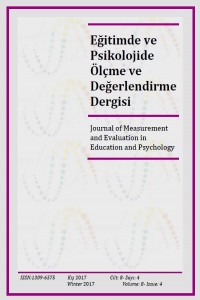The Impact of Q-matrix Misspecification and Model Misuse on Classification Accuracy in the Generalized DINA Model
Abstract
This simulation study
explored the impact of Q-matrix misspecification and model misuse on examinees’
classification accuracy within the generalized deterministic input, noisy “and”
gate (G-DINA) model framework under the different conditions. The data was
generated by saturated G-DINA
model. Along with the generating model, two reduced models were used to fit the
data: the additive CDM (A-CDM) and DINA model. The manipulated conditions
included number of respondents, attribute correlations and test length. Two
types of classification accuracy were examined: the overall classification
accuracy and the class-specific classification accuracy. Results showed that
the Q-matrix misspecification influenced classification accuracy more ominously
than model misuse. The proportion of examinees classified correctly for each
latent class was related to the types of Q-matrix misspecification. More test
items had greater positive impact on classification accuracy than more
respondents taking the test.
References
- Henson, R., Roussos, L., Douglas, J., & He, X. (2008). Cognitive diagnostic attribute-level discrimination indices. Applied Psychological Measurement, 32(4), 275-288.
Abstract
This simulation study investigated the impact of Q-matrix
misspecification and model misuse on examinees’ classification accuracy within
the generalized deterministic input, noisy “and” gate (G-DINA) model framework
under various conditions. The data was generated in the saturated G-DINA model.
Along with the
generating model, two reduced models were used to fit the data: the additive CDM (A-CDM)
and DINA model. The manipulated conditions included: number of respondents,
attribute correlations and test length. Two types of
classification accuracy were examined: the overall classification accuracy and the class-specific
classification accuracy. Results showed that the Q-matrix
misspecification influenced classification accuracy more ominously than model
misuse. The proportion of
examinees classified correctly for each latent class was related to the types
of Q-matrix misspecification. More test items had greater positive impact on
classification accuracy than more respondents taking the test.
References
- Henson, R., Roussos, L., Douglas, J., & He, X. (2008). Cognitive diagnostic attribute-level discrimination indices. Applied Psychological Measurement, 32(4), 275-288.
Details
| Journal Section | Articles |
|---|---|
| Authors | |
| Publication Date | December 28, 2017 |
| Acceptance Date | October 16, 2017 |
| Published in Issue | Year 2017 Volume: 8 Issue: 4 |


